Buses in Bolivia
A whole post about buses! ‘How exciting!’, I hear you exclaim. But what is it about buses in Bolivia that merits an entire blog post? What about the buses in Chile, Argentina, Paraguay, Brazil, and Uruguay?
Well… when we took buses in those countries, usually nothing particularly unusual happened – but while we are talking about buses, I will say that the buses in Southern Brazil were FAR superior to the rest (mostly on time, good clean toilets, new, comfortable, free drinking water on a lot of them, meal stops, no picking up random people by the side of the road etc.), and that the buses in Argentina were ALWAYS late, by many hours… other than that, not much to say.
HOWEVER, in Bolivia, going on a bus was a WHOLE DIFFERENT BALLGAME…
First of all, they pretty much never have toilets on board – yes, so we had to develop a ‘toilet strategy’ and limit the amount that we drank at certain times. We figured out that the ‘required’ time to be able to last without going to the toilet was around 5 hours. YES – that’s a long time for old people like us who like to drink water! So if a bus journey was less than 5 hours duration, then there would be no toilet, and no stopping. For journeys over 5 hours, the bus would pull over somewhere iin the middle of the journey for people to buy food and use the toilets.
We learnt to deal with this 🙂 – but of course if the bus is delayed that can throw a spanner in the works… Also, there is an exception for the bus driver and conductor – when they need to go, they just pull over at the side of the road, get out, and pee on the road – it doesn’t really matter where. When this happens, all the men on the bus who also need to go, run out of the bus at high speed, and also pee on the road (except for shy foreigners like me, who just hold it in).
This is pretty unfair on the women on the bus (and the shy foreigners! 🙂 ) – but they seem to suffer in silence – one of them told CC that she had to ‘use the force’ to keep it in…. yes, well….!
Anyway, I’m not writing this post just to talk about the lack of toilets on the buses… no… it’s because on EVERY single bus journey that we took in Bolivia, something happened to make the journey not as it should have been…. some incidents were more major than others, but I don’t think any of our bus journeys were what you might call ‘smooth sailing’…
Our first bus journey in Bolivia was La Paz to Oruro – in theory a nice simple journey of around 4 hours. It only took 30 minutes on the bus for things to go wrong! We hadn’t even left the urban area, and were on the edge of El Alto when the bus abruptly stopped. Looking out the window we saw a large group of protesters with banners, and a row of burning tyres across the road?! Yes, you know that you are not going anywhere in a hurry when there is a row of burning tyres blocking the road and a big crowd behind it… 🙁
We had read that when there is a ‘bloqueo’ – eg, a protest blocking the road (which are relatively common in Bolivia) that they sometimes last MORE THAN 24 hours?!?! – meaning that you end up sleeping on the bus while you wait?! Thankfully in this case, if we wanted to, we could get off the bus and go back to La Paz on a city bus if we had to – as we hadn’t even really left La Paz properly and so weren’t stuck on a deserted road in the middle of nowhere…still, we had no idea how long this was going to last so we just sat on the bus and waited to see what everybody else would do.
After around 2 hours, nobody had moved – the people on the bus didn’t seem too concerned, and a load of police in riot gear turned up. None of this changed anything, but the tyres had stopped burning and nobody lit any new ones – good sign?! 🙂
The word on the street was that this was a student protest about something or other, so they would probably be leaving soon. This was good news, as we didn’t really feel like going back to La Paz and starting again tomorrow. Finally after around 3 hours the crowds started to disperse, and after 4 hours we were on our way again! We were very relieved to be actually moving towards Oruro, and also now had a newly instilled paranoia about every bus journey being blocked for hours!
In light of the delay, the driver allowed us off the bus at the next pickup point to use the toilets – this was a very popular activity after being on the bus for around 5 and half hours….
So a four hour journey turned into around eight hours, and for the icing on the cake, when we arrived in Oruro we discovered that they had built a brand new bus station around 5km from the town. We had booked our hostal just a 10 minute walk from the bus station… YES, the OLD bus station… The new bus station was totally in the middle of nowhere on the edge of the city. So rather than a simple 10 minute walk, we had to find a taxi instead. (We didn’t really fancy walking through the suburbs of Oruro for over an hour just as it was going dark… and also we had no idea how to get there?! )
Finally we arrived at the hostal – only 5 hours later than we should have done – could have been worse I suppose… but not the best start to riding the buses of Bolivia.
Two days later, we were back on the buses again – this time we were going from Oruro to Uyuni. This in theory was another nice, simple journey of around 3 and half hours. The road had been recently paved, and so this route was a lot quicker now than it used to be. However, this journey went wrong BEFORE it actually started?!
We had a bus booked at 10am, but when we asked the guy in the hostal to call us a taxi to go the bus station, he replied that ‘there weren’t any‘. How can there be no taxis?!? Really?!
It turned out that this particular Sunday had been declared a ‘clean-up’ day by the council, and NOBODY was allowed to drive on the roads until 1pm?!? (Including taxis). Instead, people were meant to be cleaning the pavement and bit of road in front of their house?!
Sure enough, the streets were entirely devoid of vehicles – it was suggested that we would need to walk to the ring road and see if there were any taxis there… As the ring road was around 3km away and the bus station 5km away, we just decided to go to the bus station. Time was pretty tight, and so we set off at high speed through the empty streets of Oruro with our handy map drawn on a scrap of paper. Unfortunately it was a quite a complicated route, and the streets of Oruro are quite devoid of street name signs…
We arrived at a junction where we weren’t entirely sure which direction to go, and so we asked a policeman who was directing traffic which way the bus station was – this turned out to be a big mistake as he was very grumpy, and proceeded to berate us for not having a phone with GPS on it, telling us it was really far, and telling us to go and get a taxi. He was doing all of this whilst in the middle of having a conversation with someone else, taking ages and using up precious time, and ALSO NOT ACTUALLY TELLING US which direction the bus station was…. FINALLY he grunted and pointed down the street… we were off again…
We arrived at the bus station just before 10am, to find that the bus company office was closed and that all buses had been cancelled until 1pm. Because nobody was allowed to be on the road in Oruro that morning, most of the bus drivers, bus company staff, and bus station staff had not been able to get to work… YES, what we wondered about in all of this was – how did everybody not know about this yesterday?!?!
So, we bought another bus ticket from a different company for a 12pm bus (It actually ended up leaving at 1.15pm – no surprise really…) and the only bright side was that the other company finally opened their office and actually gave us a refund for the original 10am ticket. YES! 🙂
Once we left, the journey went quite smoothly – with only one delay when the bus pulled over to the side of the road for quite a long time for no apparent reason (waiting to see if more passengers turned up?) This event led us to discover that part of the culture of riding buses in Bolivia is to start shouting loudly ‘VAMOS’ (Let’s go) if you think the bus is being delayed unnecessarily by the driver. While we were parked waiting to go, several of the passengers begain shouting ‘VAMOS, VAMOS’. Some of them even stamped their feet and banged on the windows. This was something that we soon learned to join in on – but only in the ‘shy foreigner’ way – this meant that if I thought the bus was being delayed too much, I would pretend to be shouting ‘VAMOS’, but actually just say it quietly to CC… 🙂
Our next bus journey in Bolivia was from Uyuni to Sucre. This journey went pretty well compared to the others. The small hitch was that we had to get off the bus in Potosi after around 4 hours, and then get on another bus that went to Sucre. The only problem being that our seat numbers on the new bus had also been allocated directly to somebody else. We sat somewhere else, but then someone else had those numbers, and so they sat somewhere else etc etc. Finally though, a lady boarded the bus and refused to sit anywhere except in her numbered seat. By now there was a chain of around 6 people all in the wrong seats. Everybody stood around arguing for a while and then the bus company lady boarded the bus and spent 20 minutes moving everybody from seat to seat. Ah well, we arrived in Sucre only a bit late and both parts of the journey were very scenic – so not too much to complain about with this one 🙂
Next up on the Bolivian bus saga, was the bus from Santa Cruz to Trinidad. This was in theory a 9 hour bus journey – YIKES! So we booked the ‘posh’ bus service. In reality it wasn’t really a ‘posh’ bus. In Bolivia, ‘posh’ just means ‘more space and not totally decrepid’.
This bus left around 45 minutes late, which we were quite pleased about (yes, how expectations change….! 🙂 ) (We also got some ‘VAMOS’ action, which we like 🙂 ) but unfortunately on the outskirts of Santa Cruz a car hit us from behind and made a massive dent in the back of the bus, leaving part of a metal door hanging off.
YES, well it looked pretty bad – but this is Bolivia, and the show must go on. The driver phoned the bus company who had to come out and take a look, take some photos, and then we were free to proceed – with a big dent and a loose door – no worries! The engine was working and that’s all that matters. 🙂 This delay was a bit over an hour – so all in all we only arrived around 3 hours late! 🙂 The journey itself was very nice – we saw rheas, capybaras, herons and lots of other birds out of the window.
We arrived in Trinidad at around 10pm, and not wanting to walk across town at this late hour, we looked for a taxi, but were surprised to find only motorbike taxis. NOT those NICE mototaxis where there is a seat attached (like a tuk-tuk) – but just actual motorbikes?! When you take a mototaxi in Trinidad, it means sitting on the back of a motorbike behind the guy driving the motorbike. As it’s just an actual motorbike, there is nowhere to put luggage – so you are meant to ride with your backpack on?! Seeing as we had 2 bags each, we didn’t really fancy taking a mototaxi each, and trying to stay balanced on them with all our luggage…. yes, scaredy-cats aren’t we? 🙂
In the end, we found someone who worked at the bus station to take us to where there might be a taxi that is an actual car – yes! result! Finally we made it to the hostal. It turns out that there are only around 10 actual car taxis in the whole city?! (And like a THOUSAND motorbike taxis…)
The next time we had to take a bus, was in fact this same journey in reverse – Trinidad to Santa Cruz. This time we walked to the bus station, ready for our 10am bus…. Only 30 minutes late at 10.30am, we were off! Not even time for any passengers to start shouting ‘VAMOS’!
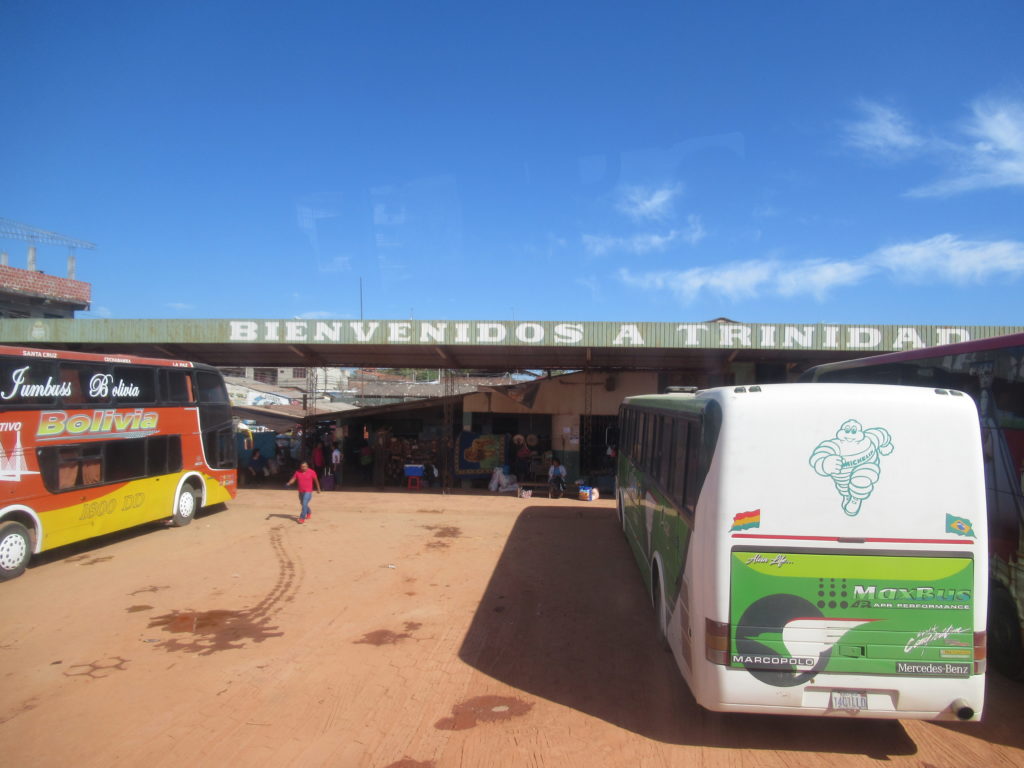
But yes, you guessed it! Something was bound to happen, and at around 12.30pm the bus broke down…. oh dear… the driver/mechanic tried to fix it… we managed to drive a bit more… the bus broke down again…. that was it…
Unfortunately, the driver was not the best communicator about what was going to happen – and soon many of the people on the bus were shouting and arguing. It was around 30 degrees and most people on the bus didn’t seem to have any food or water?! The driver couldn’t get the bus to work, and couldn’t seem to get hold of the bus company either…. NOT TOO GOOD! Nobody seemed to know if we would be rescued, or if we would be stuck here for the whole night… compared to everybody else, we seemed to be relatively calm (but maybe that’s because we had brought food and water with us).
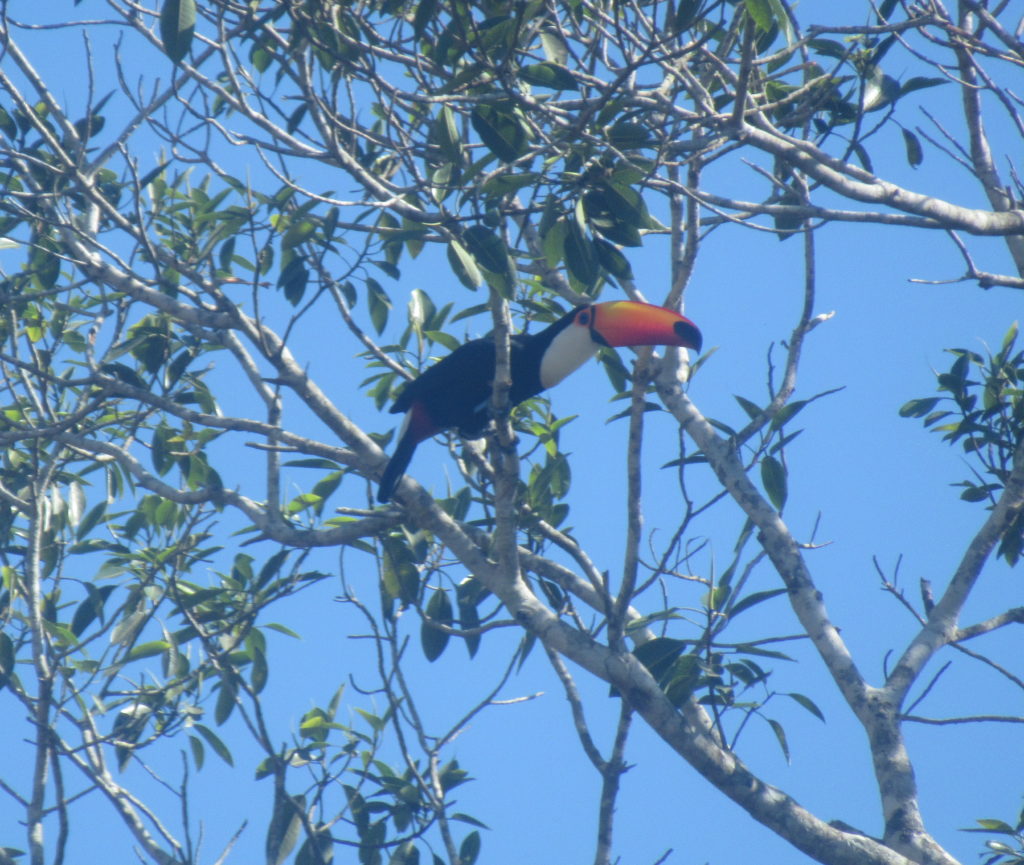
We speculated as to why anyone from Bolivia – knowing how crap the buses are – would get on a bus through the middle of nowhere without bringing any food or water…?!?!
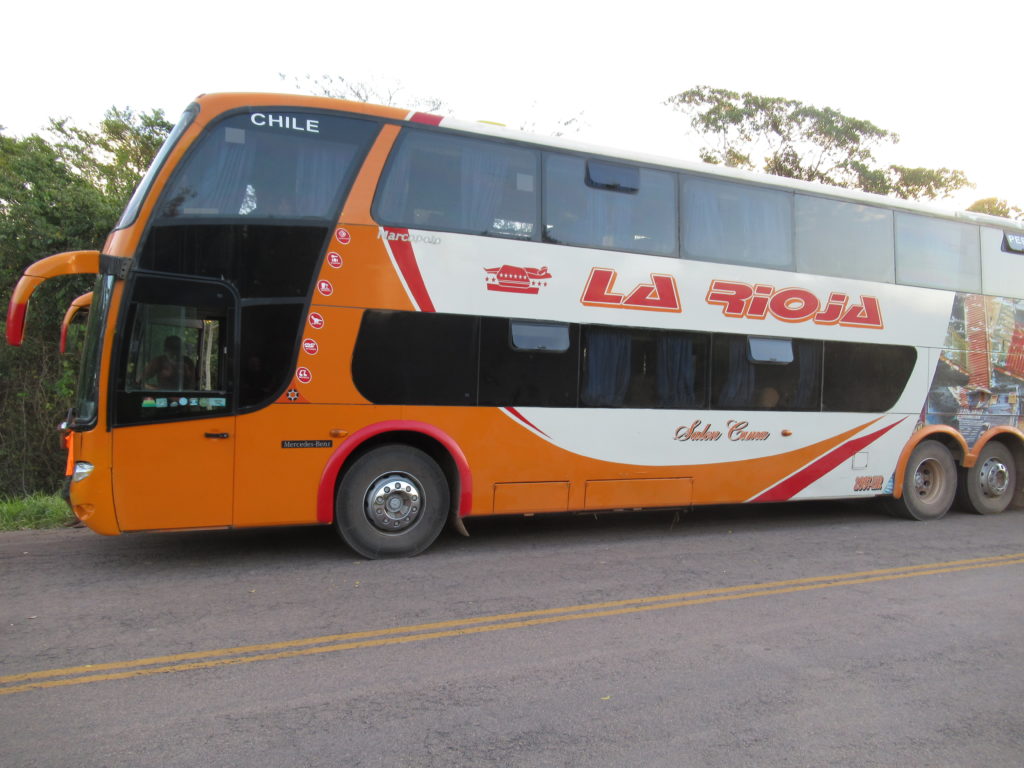
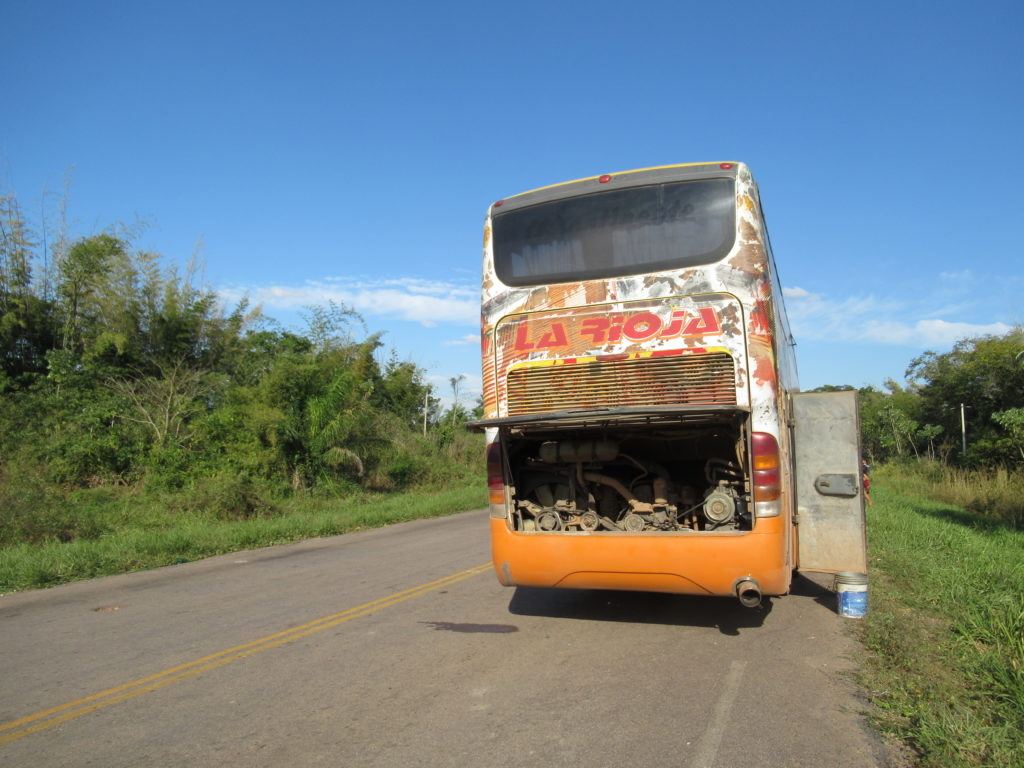
The matter was finally resolved, and we ended up spending SIX hours by the side of the road, until finally at around 6.30pm a replacement bus came to take us to Santa Cruz. We arrived at 2am in the morning – seven hours late.
Fortunately Santa Cruz is a 24-hour kind of city, and there were plenty of taxis around. Unfortunately, our hostal had crappy signage and we were unable to find it for over 10 minutes when we arrived. We were just about to give up, when the taxi driver found someone walking back to their house nearby after a night out, and asked them if they knew where the hostal was. YES! We were within a minute of giving up and trying to find somewhere else – THANKS TAXI DRIVER! (Although he did keep the change… but we figured he deserved it…)
By now, we knew that we were CURSED when it came to bus journeys in Bolivia – so we approached them expecting things to go wrong, and were quietly happy if only something minor happened!
Next up – Santa Cruz to Cochabamba – another 10 hours… Our 8am bus left at around 9am – could be worse…
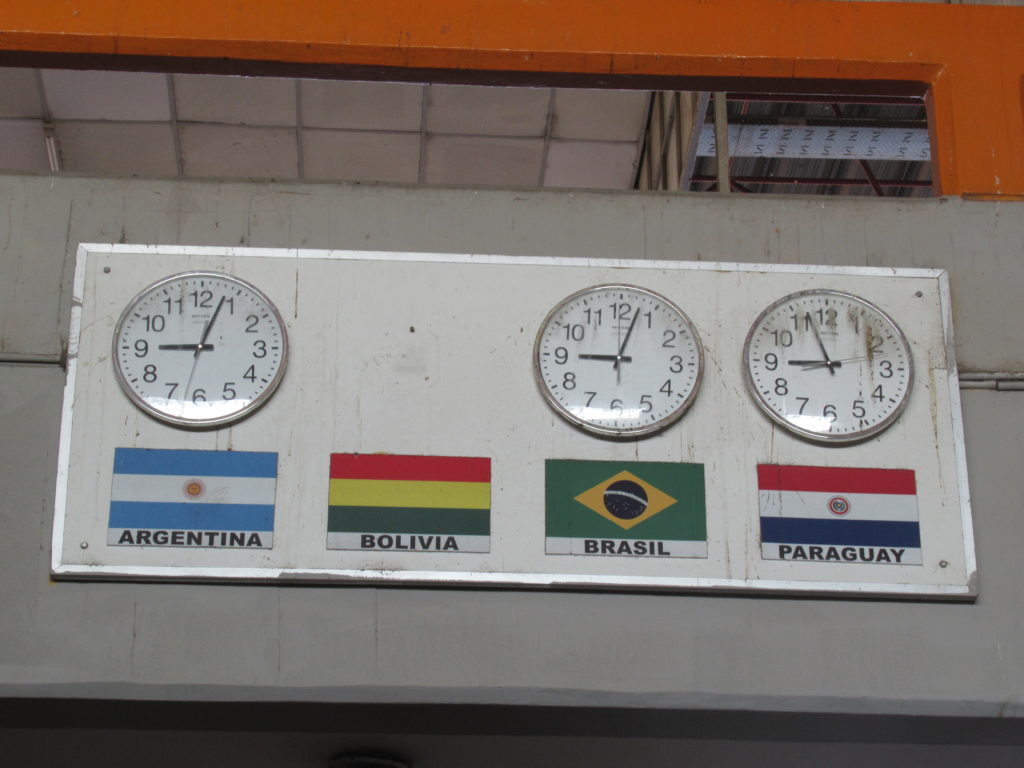
However, the actual journey proved to be a little torturous… first of all, we had made sandwiches using ‘wraps’ instead of bread (for a change) – this turned out to be disastrous, as the avocado and cheese had somehow disintegrated the wraps and turned them into a weird tasting paste…
Next up, the passenger behind us had their window open (no aircon on these buses) and the sun came through and gave CC sunburn on her neck 🙁
AND FINALLY… the people across the aisle from us had brought their dog on board – YES, we all know that dogs should be banned from bus travel… but anyway – the dog decided to pee on the floor and it ran all down the bus and under our seat 🙁 🙁 The man with the dog tried to wipe it up, but if CC’s looks could kill, then this man would definitely be dead now…!
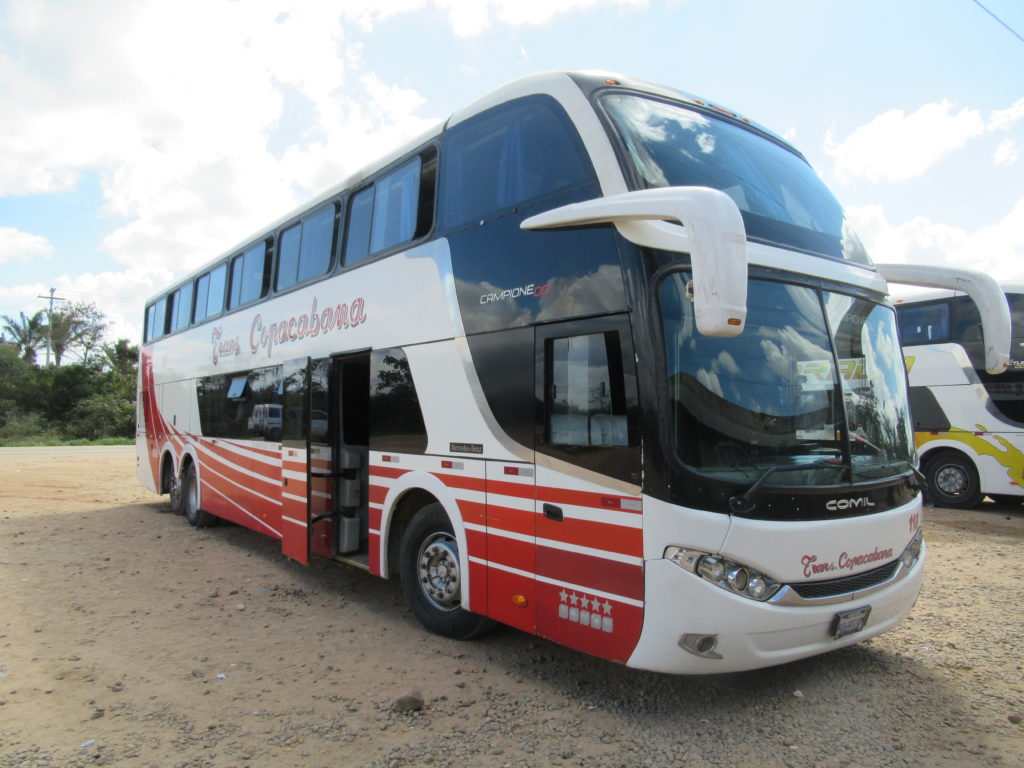
When we finally arrived in Cochabamba, only two hours late, we thought we had gotten off quite lightly…. but NO…. upon approaching the bus station there was a HUGE traffic jam of about 30 buses all trying to get into the bus station. The driver just joined the line and then stopped his engine.
As people started to get off, we asked the driver what was going on. He said that it was always like this, and it could take over an hour to get the bus into the actual bus station…. so we may as well get out. The bus station was a 5 minute walk away.
This would have been fine, except that we had read everywhere that the area around the bus station in Cochabamba is dangerous at night time. In fact when buses arrive at 4am – before the bus station opens – everyone stays sleeping on the bus, and only gets out when it gets light… YES, great….
It was only around 8pm, but it was dark and we were in some kind of crappy alleyway – it wasn’t a situation very conducive to getting out of the bus. However, everybody else was, and the engine was off – so we figured it was the best option. So off we went, heading down the dark, crappy alleyway – trying to stay close to other people from the bus. But they all went and either got picked up by somebody, or flagged a taxi down in the street. We weren’t that keen on getting in an unmarked taxi in a dark alley, so we pushed on towards the bus station by ourselves…
In the end, we got to the bus station without disaster striking and found an official taxi to take us to our hostal… another day, another messed up bus journey….!
We had reached the point where we were wondering what else could actually happen on a bus journey, and had worked out that we only had two ‘big’ bus journeys left. By ‘big’, I mean the size of the bus – many journeys in Bolivia are done in shared taxis or shared mini-vans, which leave when they are full. All of our journeys in these had gone to plan – so our ‘curse’ was only for the ‘big’ buses…
Cochabamba to La Paz was up next – a nine hour journey. Off we went to the bus station, only to find that all the buses had been cancelled as it had snowed heavily on the altiplano near Oruro, and the road was not passable… So, back we went to the hostal in Cochabamba for an extra night. We eyed up the weather forecast and asked reception in the hostal how we could find out if the buses were running the following morning – so we could avoid checking out and going to the bus station again, only to have to come straight back. Their answer was that ‘you need to go to the bus station and ask’… OK….
In the end, the bus did run the next day – and it arrived only an hour and 20 minutes late! Pretty good – as the weather was still actually pretty rough and snowy. We were quite pleased with this bus incident compared to the other ones…
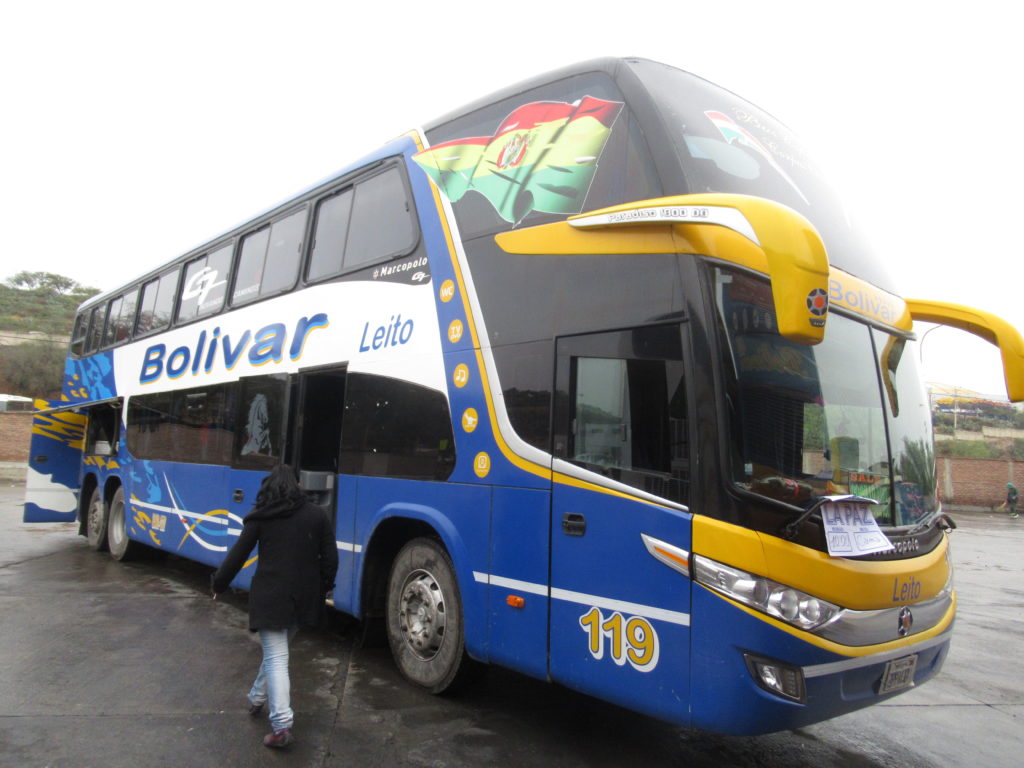

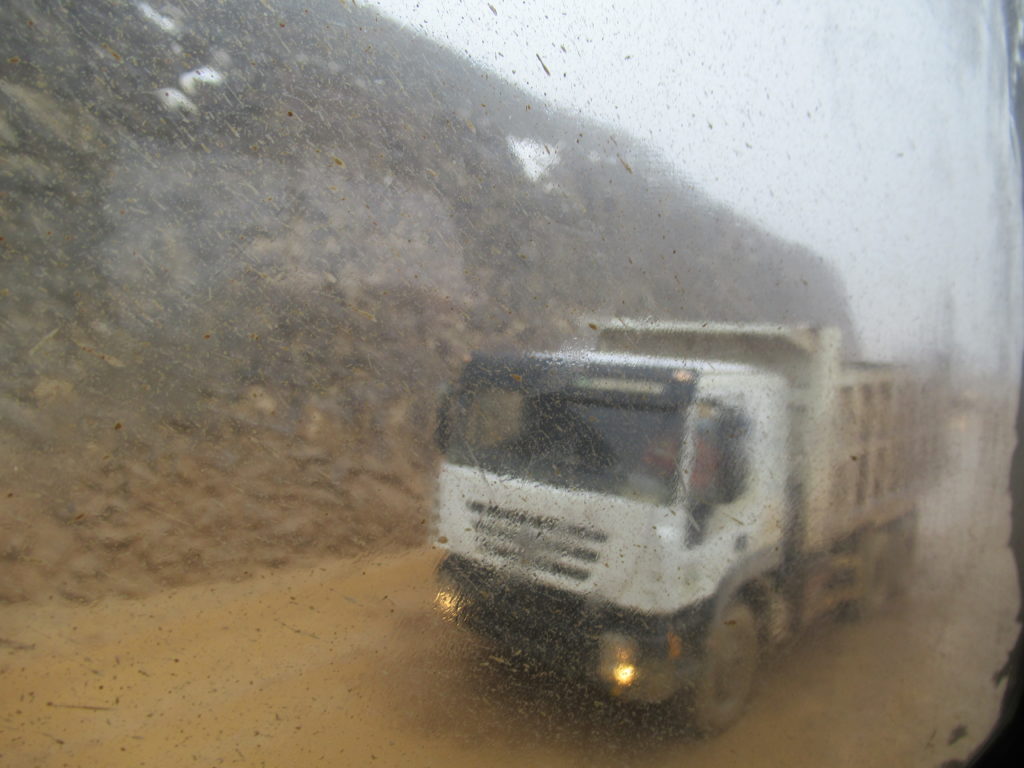

And so… FINALLY – our very last bus in Bolivia! Would we break our curse and have everything run perfectly? We were going from La Paz to Copacabana – a journey of only four and a half hours. A special journey in a way, as Copacabana is in a part of Bolivia that is cut-off from the rest of Bolivia by water on one side, and the Peruvian border on the other side. This is because the border of Peru and Bolivia runs through the middle of Lake Titicaca – part of Lake Titicaca is in Bolivia, and part is in Peru.
So to travel to Copacabana, you either have to go via Peru, or use a ferry to cross part of Lake Titicaca. The buses from La Paz use the ferry – so we had a ferry crossing to look forward to as well!
Well the curse wasn’t really broken, as when we went to the bus terminal to buy our tickets the day before we wanted to travel, the lady at the desk said that no buses were running because the road had been blocked by a protest…. OK… so we asked how long the blockade had been going on for, and apparently it was 3 days already. We then enquired as to what the protest was about, and how long it was likely to go on for. We didn’t really like the answer, which was that the protest was INDEFINITE / FOREVER??! What? Yes, until the demands were met….
The ‘demands’ turned out to be that the community of the town of Tiquina, where the ferry crossing was, wanted a bridge built – apparently because the ferry was a bit dangerous and a big pain… OK great – clearly it would be a long time before a bridge would be built… (plus, we were meant to be using the ‘dangerous’ ferry….?!)
The only ray of hope was that apparently if the authorities gave a commitment to build a bridge, with some kind of timeline, then the blockade would be lifted at the weekend. So, back to the hostel for another night in La Paz for us….we felt almost satisfied that we had managed a clean sweep of disrupted bus journeys in Bolvia! 🙂
In the end, we decided to wait the two extra days until the weekend and see if we could still go. If the blockade was still on, then we would go to Puno, Peru. From there, we would have to decide if it was worth backtracking to Bolivia again to access Copacabana from the other side. But guess what? When we went back to the bus terminal two days later the blockade had lifted! Yes – we were going to Copacabana, and seeing as we had already had our bus mishap, we were guaranteed a smooth journey! 😉
Well actually, it was a straightforward and enjoyable journey. The scenery was great, the bus left on time and arrived on time, and the dangerous ferry turned out to only be dangerous for the bus driver – as only the drivers of vehicles stay on board the vehicle during the crossing – everyone else gets to take a DIFFERENT ferry just for passengers. Yes, the vehicles go on one ferry, and the passengers go in a different one….
That might sound strange until you see what the vehicle ferries look like…then you will understand why they are dangerous, and also why the passengers go separately! Our bus and all the passengers made it safely across, and we were in Copacabana shortly afterwards. So a good end to our ill-fated bus travel experiences, and I will leave you with some pictures of our last bus journey in Bolivia…
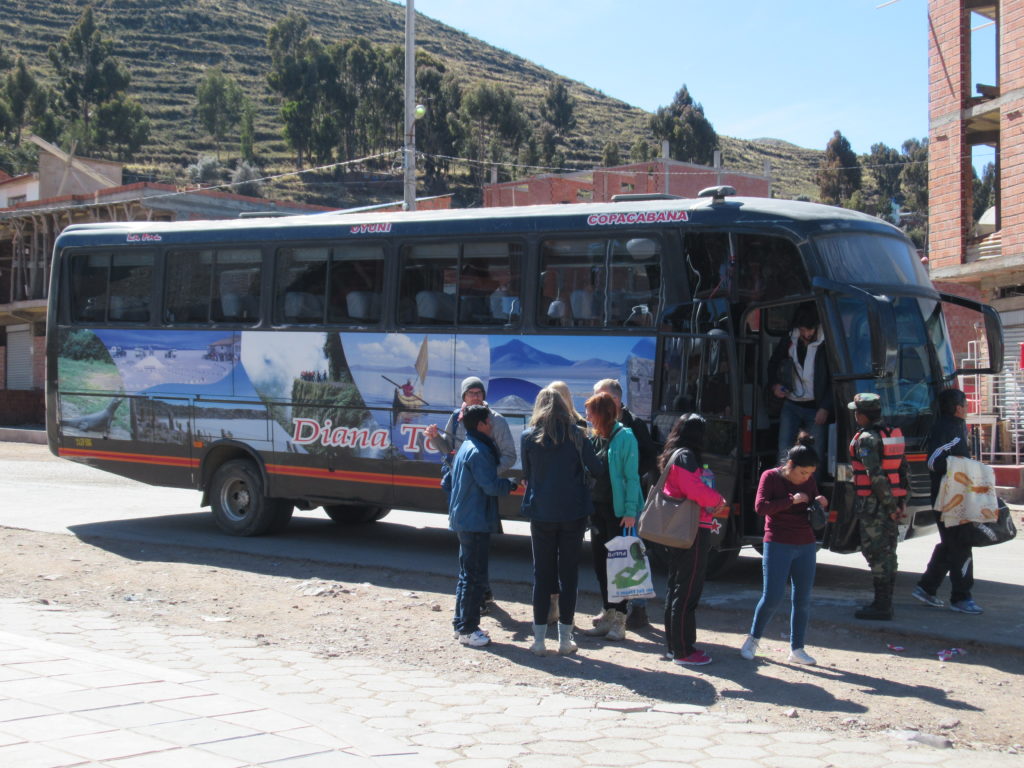
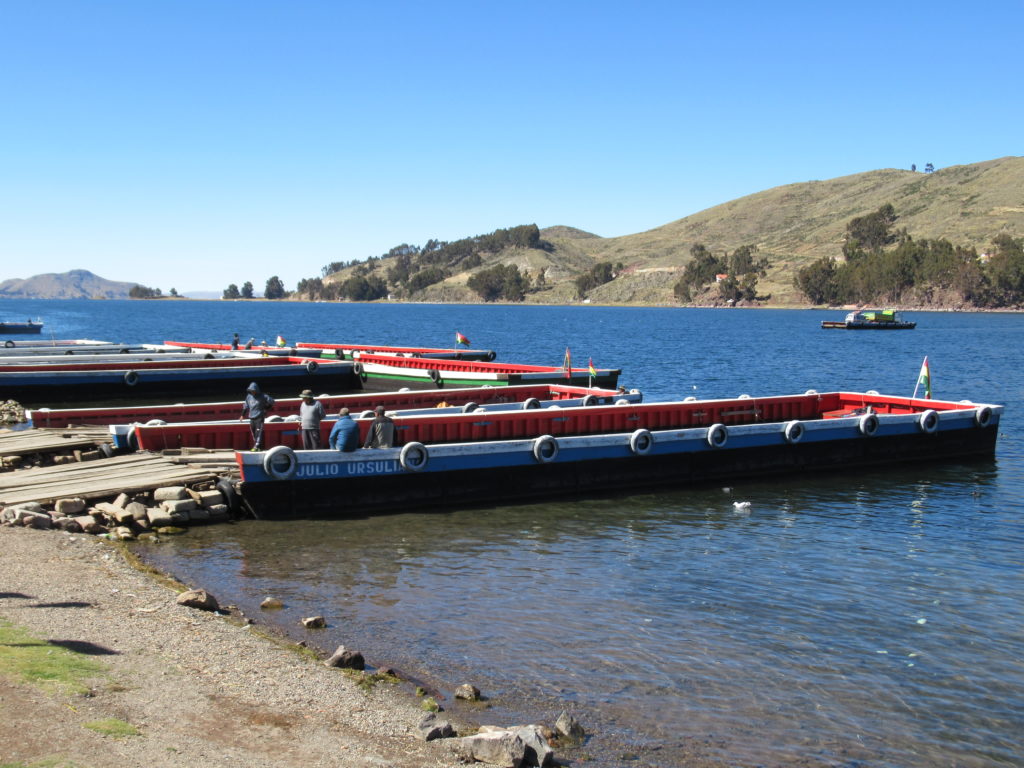
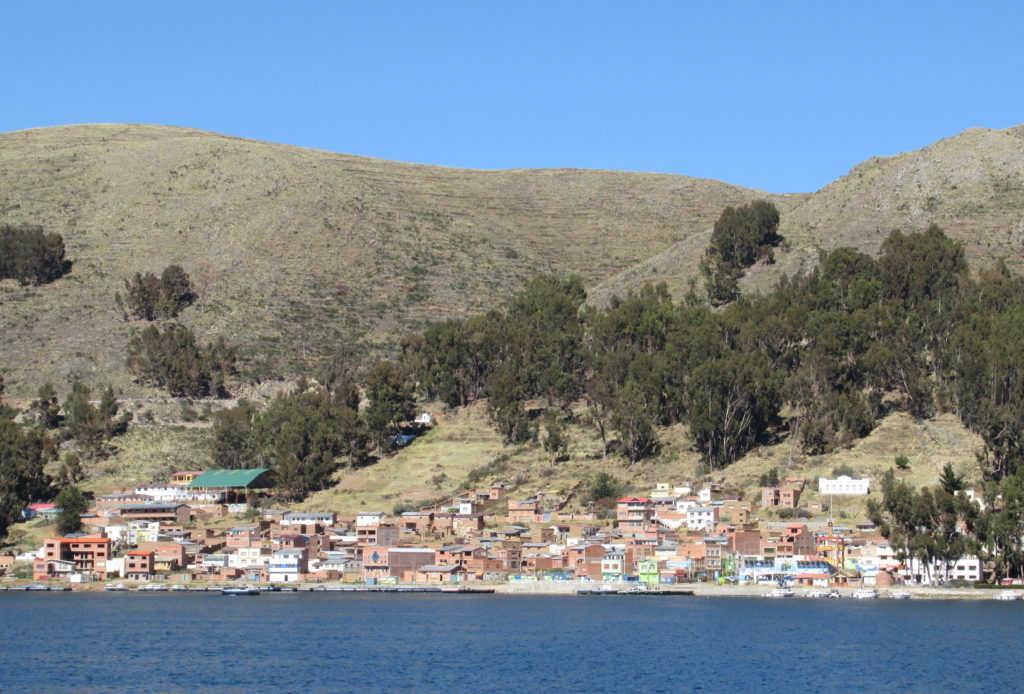
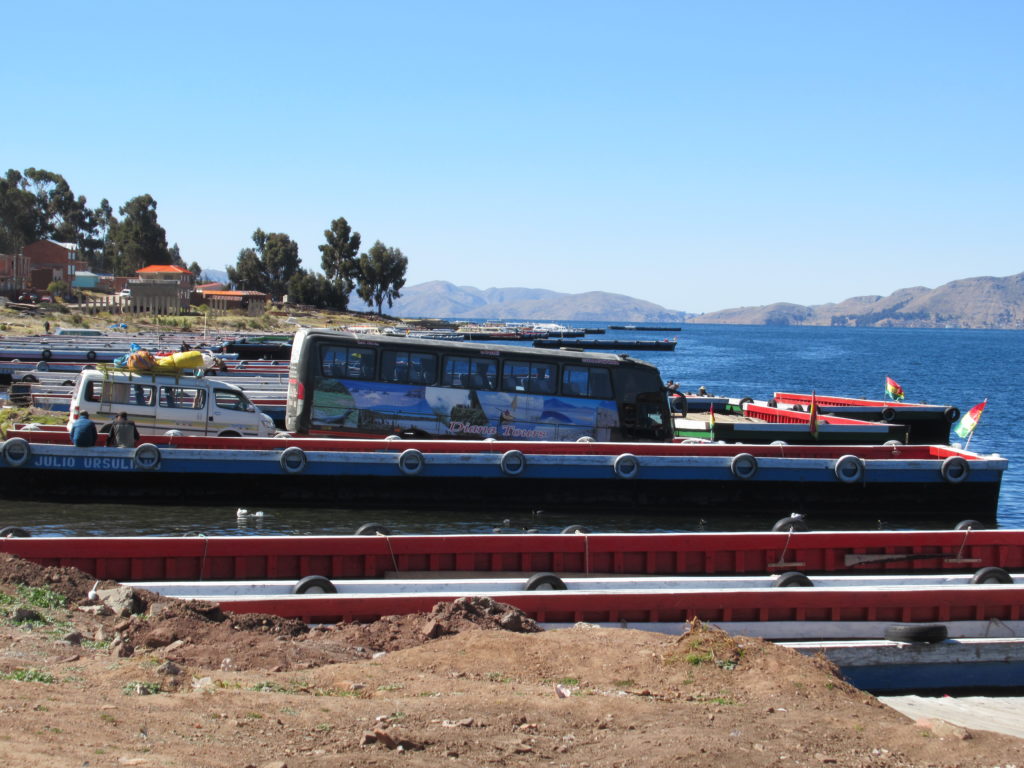
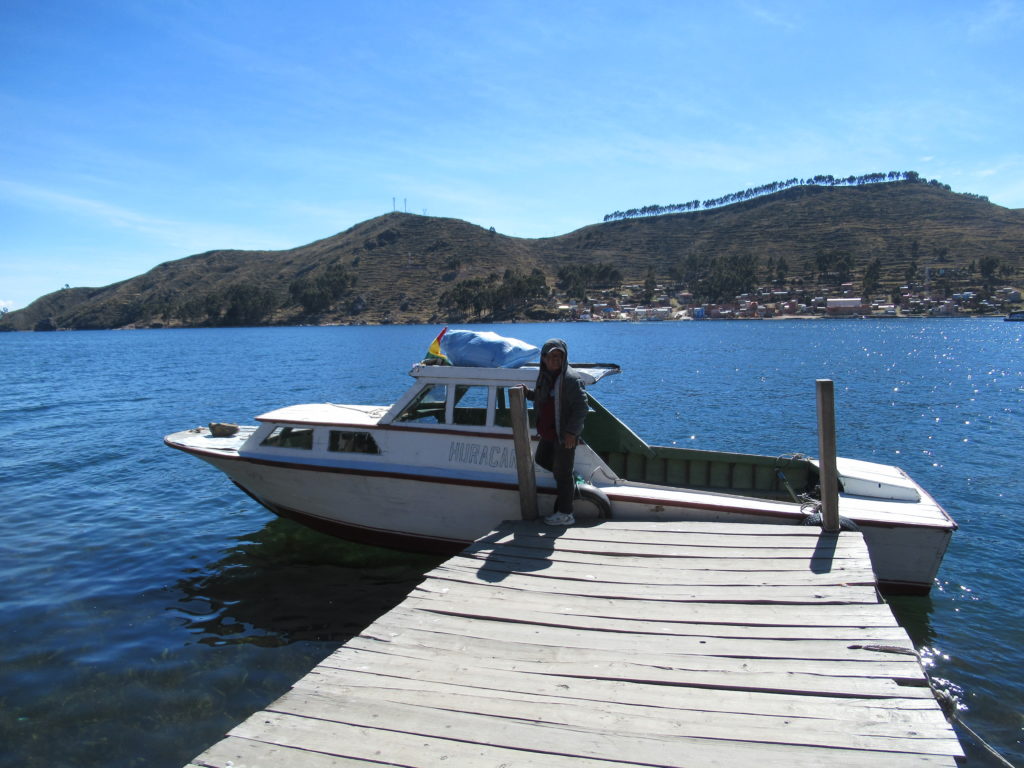
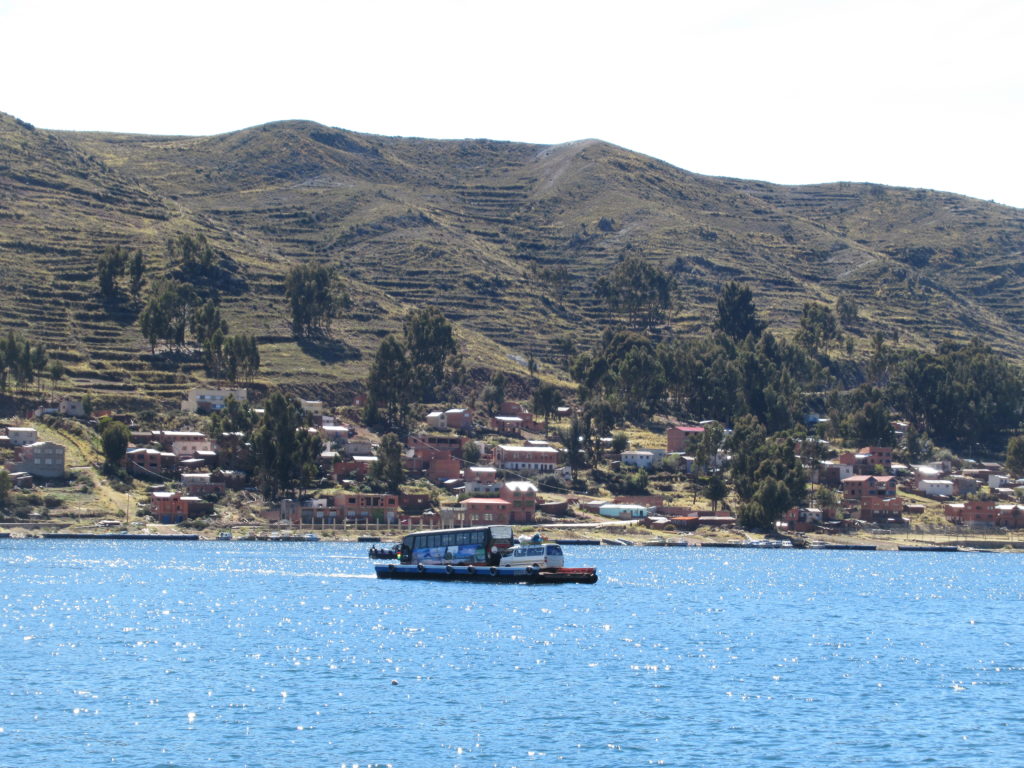
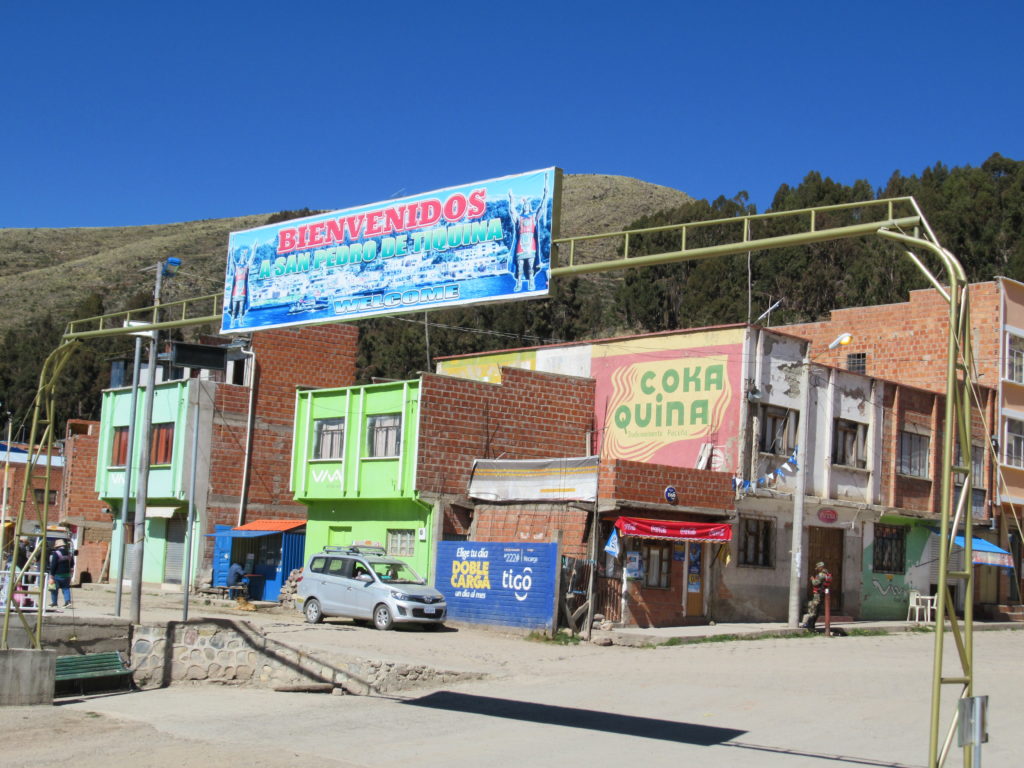
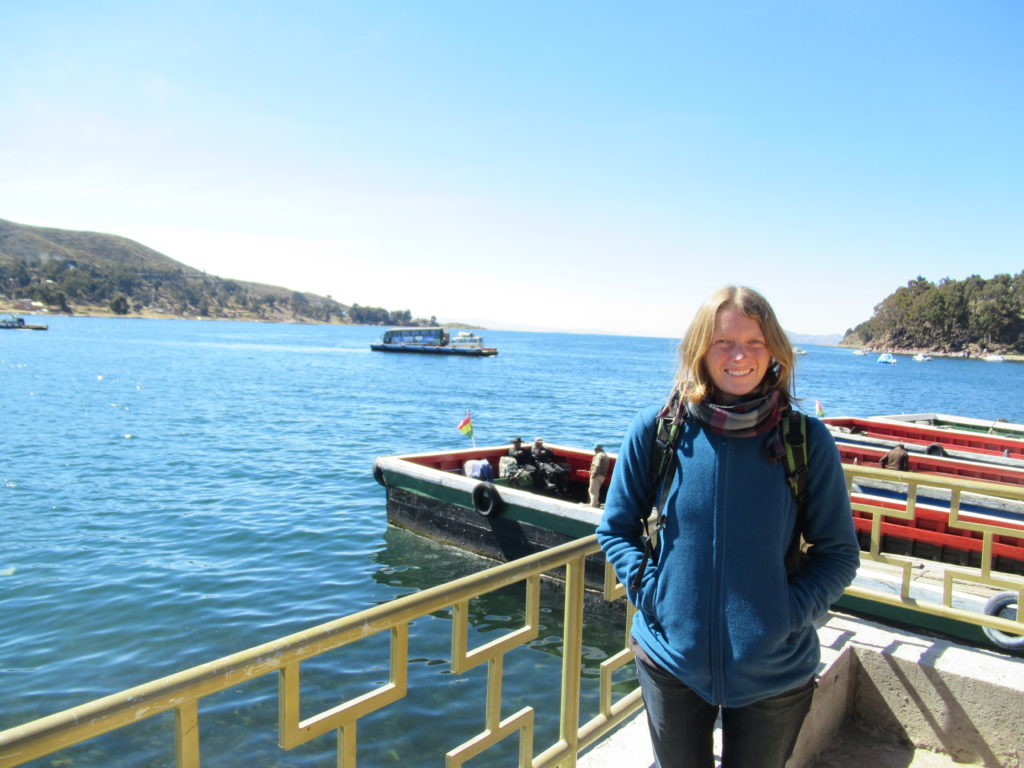


I will like to experience the road once I visit Bolivia next week.